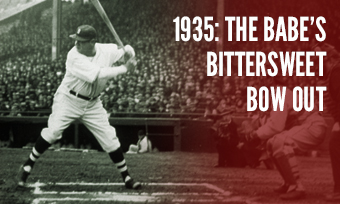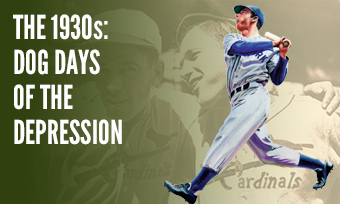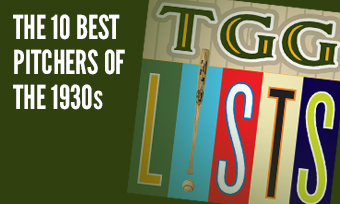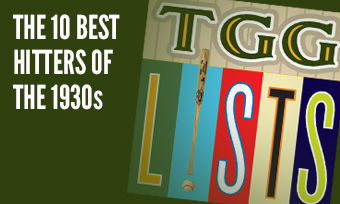The Yearly Reader
Leaders and Honors, 1935
Our list of baseball’s top 10 hitters and pitchers in both the American League and National League for the 1935 baseball season, as well as the awards and honors given to the game’s top achievers of the year.
The National League’s Top 10 Hitters, 1935
Bold type in brick red indicates league leader.
1. Arky Vaughan, Pittsburgh
Key Numbers: 137 games, .385 average, 108 runs, 192 hits, 34 doubles, 10 triples, 19 home runs, 99 RBIs, 97 walks, .491 on-base percentage, .607 slugging percentage.
Honus Wagner apparently did a pretty good job tutoring shortstop Vaughan, who hit higher than the great Wagner ever did.
2. Joe Medwick, St. Louis
Key Numbers: .353 average, 132 runs, 224 hits, 46 doubles, 13 triples, 23 home runs, 126 RBIs.
Among Medwick’s many achievements on the year was the NL’s longest hitting streak (28 games) and the league’s only cycle on the year.
3. Mel Ott, New York
Key Numbers: .322 average, 113 runs, 191 hits, 33 doubles, 31 home runs, 114 RBIs, 82 walks.
As if opposing defenders needed to make it tougher on their pitchers, Ott led the NL in reaching base via error (24 times).
4. Ripper Collins, St. Louis
Key Numbers: .313 average, 109 runs, 181 hits, 36 doubles, 10 triples, 23 home runs, 122 RBIs, 65 walks.
A mild drop-off from his superlative 1934 effort; unfortunately, the slide would continue until 1939, when he was sold to the Pacific Coast League.
5. Augie Galan, Chicago
Key Numbers: .314 average, 133 runs, 203 hits, 41 doubles, 11 triples, 12 home runs, 79 RBIs, 87 walks, 22 stolen bases, 15 caught stealing.
In a breakout campaign for the sophomore speedster, Galan became the first known player to log action in every game and not hit into a double play.
6. Wally Berger, Boston
Key Numbers: .295 average, 91 runs, 174 hits, 39 doubles, 34 home runs, 130 RBIs.
Babe Ruth was second to Berger on the Braves with six home runs; Pinky Whitney was second in RBIs with 60. Which leads one to ask; if Berger was so dominant and unsupported by his teammates, how did he only walk 50 times?
7. Hank Leiber, New York
Key Numbers: .331 average, 110 runs, 203 hits, 37 doubles, 22 home runs, 103 RBIs, 10 hit-by-pitches, 20 grounded into double plays.
Like Galan above, Lieber’s second major league season was arguably his best; he was part of the last NL trio to date (along with Giants teammates Bill Terry and Jo-Jo Moore) to each have 200 hits in a season.
8. Billy Herman, Chicago
Key Numbers: .341 average, 666 at-bats, 113 runs, 227 hits, 57 doubles, 6 triples, 7 seven home runs, 83 RBIs, 24 sacrifice hits.
Herman could have easily been confused with Babe Herman, both in terms of name and ability to mash a baseball.
9. Gabby Hartnett, Chicago
Key Numbers: 116 games, .344 average, 32 doubles, 13 home runs, 91 RBIs.
In a year where so many other players compiled better numbers, Hartnett managed to snatch the NL MVP—though much of that had to do with a sharp ability to steer his pitchers behind the plate while throwing out 44 of 64 attempted basestealers.
10. Johnny Moore, Philadelphia
Key Numbers: .323 average, 194 hits, 33 doubles, 19 home runs, 93 RBIs.
Not to be confused with the Giants’ Jo-Jo Moore, Johnny thrived in the relatively easy offensive environment of Philadelphia’s Baker Bowl—hitting .354 at home while collecting a .289 figure on the road.
The American League’s Top 10 Hitters, 1935
1. Hank Greenberg, Detroit
Key Numbers: .328 average, 121 runs, 203 hits, 46 doubles, 16 triples, 36 home runs, 168 RBIs, 87 walks.
Respect was initially tough to find for Greenberg, left off the All-Star Game roster despite 110 RBIs at the break; he found it at year’s end with the AL MVP.
2. Jimmie Foxx, Philadelphia
Key Numbers: .346 average, 118 runs, 185 hits, 33 doubles, 7 triples, 36 home runs, 115 RBIs, 114 walks, 99 strikeouts, .636 slugging percentage.
Starting in the place of Greenberg at the All-Star Game, Foxx knocked in all three runs in the AL’s 3-1 victory.
3. Lou Gehrig, New York
Key Numbers: .329 average, 125 runs, 176 hits, 26 doubles, 10 triples, 30 home runs, 119 RBIs, 132 walks, 21 intentional walks, .466 on-base percentage.
In his one year after Babe Ruth and before Joe DiMaggio, it was safe to pitch around Gehrig, who set a personal high for walks.
4. Charlie Gehringer, Detroit
Key Numbers: .330 average, 123 runs, 201 hits, 32 doubles, 8 triples, 19 home runs, 108 RBIs, 79 walks, 11 stolen bases.
Another year, another .300-plus average for the Mechanical Man—though winning his first World Series certainly made the season far more special than normal.
5. Joe Vosmik, Cleveland
Key Numbers: .348 average, 93 runs, 216 hits, 47 doubles, 20 triples, 10 home runs, 110 RBIs.
A brilliant year in which Vosmik became the first American Leaguer to lead the circuit in hits, doubles and triples was soured by his play-it-safe routine on the season’s final day that likely cost him the AL batting title.
6. Buddy Myer, Washington
Key Numbers: .349 average, 115 runs, 215 hits, 36 doubles, 11 triples, 5 home runs, 100 RBIs, 96 walks.
The veteran second baseman gave up smoking, took up golf and was named team captain—all in advance of a career year that ended with a batting title won by a razor-thin margin.
7. Pete Fox, Detroit
Key Numbers: 131 games, .321 average, 116 runs, 38 doubles, 8 triples, 15 home runs, 73 RBIs, 14 stolen bases.
Nearly traded to Washington after a bad start, Fox revived his game with a 29-game hit streak and a career-high 15 home runs before starring in the World Series.
8. Bob Johnson, Philadelphia
Key Numbers: .299 average, 103 runs, 174 hits, 29 doubles, 28 home runs, 109 RBIs, 78 walks.
Another fast start—hitting over .400 through the first two months—led to his first All-Star appearance, and his first of seven straight years knocking in over 100 runs for the A’s.
9. Moose Solters, Boston-St. Louis
Key Numbers: .319 average, 94 runs, 201 hits, 45 doubles, 7 triples, 18 home runs, 112 RBIs, 11 stolen bases.
Solters became the first AL player to collect 200 hits while splitting his year between two teams; fortunately for the Browns, they profited from most of his work.
10. Earl Averill, Cleveland
Key Numbers: .288 average, 109 runs, 34 doubles, 13 triples, 19 home runs, 79 RBIs, 70 walks.
In his seventh major league season, Averill hit under .300 for the first time and saw muted power numbers, but he was still effective enough to scare opposing pitchers (and make this list).
The National League’s Top 10 Pitchers, 1935
1. Dizzy Dean, St. Louis
Key Numbers: 3.04 ERA, 28 wins, 12 losses, .700 win percentage, 5 saves, 50 appearances, 36 starts, 29 complete games, 325.1 innings, 190 strikeouts.
Almost anything would have been a letdown after winning 30 games, but the hangover was almost non-existent for Dean in his post-1934 performance.
2. Cy Blanton, Pittsburgh
Key Numbers: 2.58 ERA, 18 wins, 13 losses, 4 shutouts, 254.1 innings, 55 walks.
The 27-year-old rookie was certainly the year’s underrated surprise, leading the NL in ERA, opposing average (.229) and on-base percentage (.272).
3. Hal Schumacher, New York
Key Numbers: 2.89 ERA, 19 wins, 9 losses, 18 complete games, .679 win percentage, 261.2 innings.
Schumacher had three chances to secure a second straight 20-win season, and pitched well enough to win them all—but the Giants neither couldn’t keep his leads nor score for him.
4. Bill Swift, Pittsburgh
Key Numbers: 2.70 ERA, 15 wins, 8 losses, 39 appearances, 22 starts, 203.2 innings, 37 walks.
Not related to (we have a few of these on this page) his namesake who won 21 games for the 1993 Giants—though they had eerily similar career numbers; this Swift was 95-82, the later-day one 94-78.
5. Paul Derringer, Cincinnati
Key Numbers: 3.51 ERA, 22 wins, 13 losses, 45 appearances, 33 starts, 276.2 innings, 49 walks.
After two years of 20-plus losses, Derringer said enough and won over 20 with a Reds staff from which no one else won more than eight. Further proving his first-class value on a second-class club, Derringer performed better against first-division teams than those from the second tier.
6. Carl Hubbell, New York
Key Numbers: 3.27 ERA, 23 wins, 12 losses, 42 appearances, 35 starts, 302.2 innings, 49 walks.
Conceding a league-high (and career-high) 27 home runs didn’t keep the Meal Ticket from experiencing his third of five straight 20-win campaigns.
7. Paul Dean, St. Louis
Key Numbers: 3.37 ERA, 19 wins, 12 losses, 5 saves, 46 appearances, 33 starts, 269.2 innings, 55 walks, 9 hit-by-pitches.
Like Schumacher above, “Daffy” failed in his last few starts to win his 20th game—outdueled by the Cubs’ Lon Warneke, 1-0, in his last outing. Thanks in large part to arm issues, he would win only 12 more games for the rest of his career.
8. Bill Lee, Chicago
Key Numbers: 2.96 ERA, 20 wins, 6 losses, .769 win percentage, 39 appearances, 32 starts.
Along with Lon Warneke, Lee was the Cubs’ last 20-game winner until 1969—and the last pitcher, until 1969, to be named Bill Lee (minus the nickname “Spaceman”).
9. Larry French, Chicago
Key Numbers: 2.96 ERA, 17 wins, 10 losses, 42 appearances, 30 starts, 4 shutouts, 246.1 innings, 44 walks.
In his first year with the Cubs after six seasons with the Pirates, French helped the Cubs down the stretch with five straight complete-game victories.
10. Watty Clark, Brooklyn
Key Numbers: 3.30 ERA, 13 wins, 8 losses, 207 innings, 28 walks.
A fine (if short) return to form for the 33-year old, who returned to Brooklyn a year after a brief and disastrous tenure with the Giants.
The American League’s Top 10 Pitchers, 1935
1. Mel Harder, Cleveland
Key Numbers: 3.29 ERA, 22 wins, 11 losses, .667 win percentage, 42 appearances, 35 starts, 287.1 innings, 53 walks.
No one played longer in a Cleveland uniform than Harder, who had the best showing of his 20 years with the franchise.
2. Lefty Grove, Boston
Key Numbers: 2.70 ERA, 20 wins, 12 losses, 23 complete games, 273 innings, 65 walks.
Grove captured his sixth ERA title—and first with the Red Sox—after an abysmal injured-plagued debut the year before at Boston.
3. Schoolboy Rowe, Detroit
Key Numbers: 3.69 ERA, 19 wins, 13 losses, 42 appearances, 34 starts, 6 shutouts, 275.2 innings.
Rowe won 14 of his 19 games at home, including five of his major league-leading six shutouts; he also hit .312 and knocked in 28 runs over 109 at-bats at the plate.
4. Wes Ferrell, Boston
Key Numbers: 3.52 ERA, 25 wins, 14 losses, 41 appearances, 38 starts, 31 complete games, 322.1 innings.
Bothered for two years with a sore arm after four straight seasons winning 20 games, Ferrell returned to that plateau; he also complimented his pitching with 52 hits (tied for the most ever by a pitcher) and a .347 batting average.
5. Red Ruffing, New York
Key Numbers: 3.12 ERA, 16 wins, 11 losses.
While on the subject of good-hitting pitchers, Ruffing—one of best at the plate among hurlers, ever—hit .337 over, also, 109 at-bats.
6. Willis Hudlin, Cleveland
Key Numbers: 3.69 ERA, 15 wins, 11 losses, 5 saves, 36 appearances, 29 starts.
The 29-year-old right-hander had one of the season’s most impressive outings, throwing a 15-inning shutout of the A’s on August 24.
7. Ivy Andrews, St. Louis
Key Numbers: 3.54 ERA, 13 wins, 7 losses, 50 appearances, 20 starts, 213.1 innings, 53 walks.
On a Browns staff in which only one full-time member relieved more than he started, Andrews emerged as the most effective, posting an ERA two full runs better than the rest of the team’s pitchers combined (5.57).
8. Tommy Bridges, Detroit
Key Numbers: 3.51 ERA, 21 wins, 10 losses, .677 win percentage, 36 appearances, 34 starts, 274.1 innings, 163 strikeouts.
Bridges won his first of two straight AL strikeout crowns while racking up another 20-plus wins.
9. Johnny Marcum, Philadelphia
Key Numbers: 4.08 ERA, 17 wins, 12 losses, 39 appearances, 27 starts, 242.2 innings.
Marcum found brief success with the A’s with the addition of the suddenly popular screwball to his repertoire.
10. Lefty Gomez, New York
Key Numbers: 3.18 ERA, 12 wins, 15 losses.
Gomez may have had the best 12-15 record of 1935, but don’t tell him; after Yankees exec Ed Barrow told the usually light pitcher to add 20 pounds so that he would make the fans forget Jack Chesbro, the results made Gomez crack, “I almost made them forget Gomez.”









